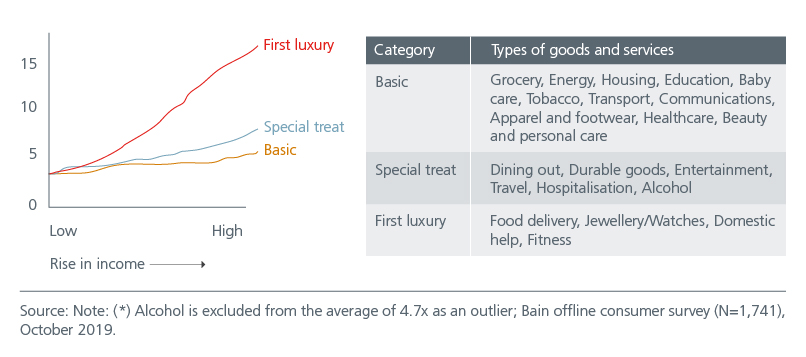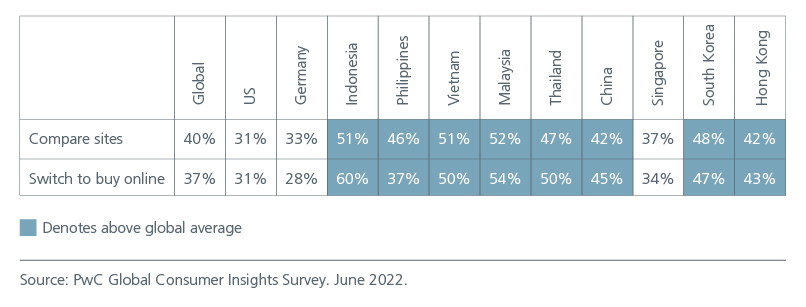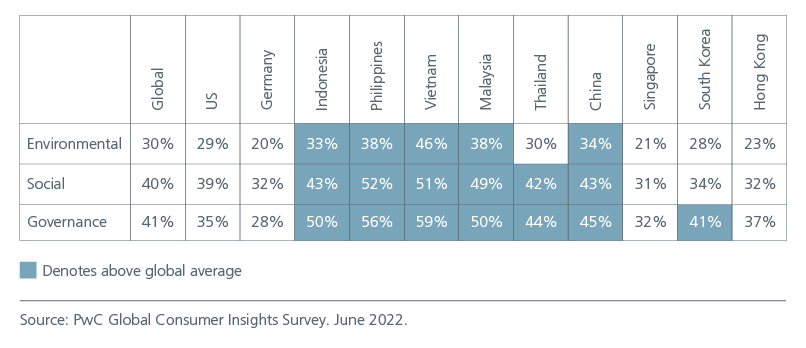Summary
The behaviour of Asian consumers is changing, resulting in both challenges and opportunities for consumer companies. We believe that Asian consumer companies will be able to maintain their dominance to take advantage of the trillion-dollar market opportunity.
According to a report by McKinsey, Asia presents a USD10 trillion consumption growth opportunity over the next decade1 - it will account for one of every two of the world’s upper-middle-income and above households, and one of every two consumer transactions in the period to 2030.
At the same time, the Asian consumer is becoming more affluent, purchasing more online, has a rising awareness of sustainability and a greater willingness to share data. Companies that understand Asia’s unique traits will be well positioned to tap the potential of Asia’s growing consumer market.
Reaching an inflection point
The varying income levels in Asia create demand for different types of goods and services. Research suggests that 78% of total consumption in Asia is made up of basic goods, with “special treat” and “first luxury” items accounting for the remaining 17% and 5%. As income levels rise, consumption in many product categories is expected to reach an inflection point and take off. See Fig. 1. ASEAN alone is expected to see 140m new consumers over the next decade with the region’s GDP per capita forecasted to reach USD6600 by 20302 . Consumer companies need to be agile to adapt their products and services to target existing and new consumer segments in order to expand their market share and diversify their revenue streams.
Fig. 1. Average capital spend by income band (indexed, 2030F)

Embracing new segments
Beyond Asia’s diverse languages, norms and cultural influences, changing dynamics are making the marketplace more complex but also providing new opportunities for consumer companies. For example, households are getting smaller with singles making up more than 30% of households in advanced Asia3 - smaller packaging for household products and pre-cooked meals are likely to appeal to these households. At the same time, parts of Asia are also growing older. According to the World Economic Forum, Japan has the oldest population within Asia where the old age to working age ratio is around 50% 4 and by 2060, it is estimated that there will be 9 seniors for every 10 working-age persons in South Korea. Due to Asia’s ageing demographics, consumption by seniors is expected to grow 1.5-2x faster than the general population, presenting significant potential for companies looking to tap the silver dollar. Products and services that enhance the quality of life and maintain independent living are likely to be popular with the senior population.
Beyond traditional segments, micro segments such as Generation Z gamers in Indonesia, digital natives in China also provide additional opportunities for consumer companies. One of Vietnam’s leading diary companies recently developed new milk products for teenagers and expectant mothers.
Meanwhile, following years of premiumisation where companies had focused on emphasising the superior quality and exclusivity of products, weaker income during the pandemic years and rising inflation have led consumers to place greater focus on value. We observed that an operator of a large convenience store chain in Thailand started to offer “value for money packs” in its product mix in the last couple of years to leverage on this trend.
Moving online for good
It is estimated that 60 million people in Southeast Asia became online consumers during the pandemic 5. While online purchases offered a way to overcome mobility restrictions during the pandemic, the convenience it provided changed consumer behaviour for good. Digital adoption is also accelerating in Asia given the region’s high smart phone penetration rates and mobile-savvy youthful populations. During the pandemic, a leading dairy company in Vietnam modernised its distribution channel and tripled the revenues from its online channel. Meanwhile, an Indonesian lifestyle retailer’s share of online sales grew more than 3x to 10.3% of total sales in the first quarter of 2022 after it developed a “chat and buy” function via Whatsapp and upgraded its e-commerce platform.
While an online presence can extend a company’s reach, it also creates challenges. Asian consumers tend to have lower brand loyalty and are more likely to compare sites. See Fig. 2. At the same time, fulfilment can be tricky for countries with large geographies and still-developing infrastructure. To overcome such challenges, an Indonesian retailer with a strong minimarket franchise has built depos and hubs across the country as well as allowed some of its principals to distribute products via their own logistics.
Fig 2. How frequently have you taken the following actions in response to rising prices and delivery delays?

A rising awareness of ESG
Asian consumers appear to have a great awareness of environmental, social and governance issues, in particular social and governance factors, such as commitment to human rights, diversity and transparency in business practices. Fig. 3.
Fig. 3. To what extent would a company’s ESG actions influence your behaviour to purchase a product or service from the company?

Companies are increasingly aware of the power of consumer activism where social media has enabled consumers to voice their support of causes and where e-boycotts can have damning consequences. We note that more Asian consumer companies are adopting sustainable sourcing, increasing supply chain transparency and reducing waste.
One of Indonesia’s leading lifestyle retailers has installed solar panels in stores and moved away from plastic utensils and single-use plastic bags since 2021. It has also collected and donated pre-loved clothes in its fashion outlets, as well as up/down cycled clothing items. A leading dairy company in Vietnam has launched plant-based milk to appeal to consumers who are looking for milk alternatives. The same company has also adopted sustainable farming techniques from breeding to production to meet quality standards, as well as animal welfare and environmental goals. Its regenerative farming practices utilises renewable energy, preserves soil and water resources, and reduces methane emissions.
Leveraging the power of data
By collecting quality data and using it effectively, companies can make recommendations based on their customers’ buying preferences and behavioural patterns. Data can also help companies identify high value customers – research suggests that tapping on high value customers is 7x more cost effective than acquiring new customers6 . The potential to leverage data is more significant in Asia as consumers appear more willing to share their data, compared to their peers in advanced countries. More than 45% of surveyed consumers in China, India and Thailand indicate that they share their data for personalisation purposes, compared with less than 30% of consumers surveyed in Europe 7.
A leading ecommerce platform in Asia that connects shoppers and sellers across Southeast Asia and Taiwan cites data as a key driver for its success. AI technology that is embedded in its mobile app collates data on shoppers’ past browsing and purchasing patterns and uses that information to push relevant products to customers. The data is also shared with its brand partners on the platform which helps in their inventory management, which is particularly useful during major campaigns, such as the annual 11.11 and 12.12 shopping extravaganzas.
Beyond increasing sales revenues, data can be used for better inventory management and improving efficiencies. A lifestyle retailer in Indonesia which has a portfolio of department and speciality stores as well as F&B businesses uses a loyalty programme across its different businesses to develop a customer database for cross selling and marketing. Data analytics helped to better predict customers’ purchasing behaviour and improve inventory management. As a result, the company managed to lower its aging inventory (> 6 months) from 38% in 2020 to 31% in 2021.
Asian brands are well positioned
The potential of Asia’s consumer market is significant but only consumer companies that can embrace digitalisation, sustainability, and data analytics within the Asian context, while providing creative products and services can stay ahead of the competition.
With Asian brands currently having a 65 – 95% market share across consumer-packaged goods, electronics, and automotives in Asia8 , we believe that Asian consumer companies are well positioned to tap the potential of Asia’s new consumers.
Contributors:
Bryan Yeong, Portfolio Manager, Equities, Eastspring Singapore
Bodin Buddhain, Head of Investment Strategy, Eastspring Thailand
Nguyen Thi Bich Thao, Head of Equities, Eastspring Vietnam
Lydia Suwandi, Equity Analyst, Eastspring Indonesia
This is the second in our series of 4 articles where we provide insights into Asia’s consumer, supply chains and resources.
Sources:
1 https://www.mckinsey.com/mgi/overview/in-the-news/the-emergence-of-new-consumer-segments-and-implications-for-companies-in-asia-and-thailand
2 World Economic Forum. Future of Consumption in Fast Growth Consumer Markets: ASEAN. 2020
3 https://www.mckinsey.com/featured-insights/asia-pacific/beyond-income-redrawing-asias-consumer-map
4 https://www.weforum.org/agenda/2020/02/ageing-global-population
5 Nikkei Asia. COVID’s striking impact on Southeast Asia’s digital economy. November 2021.
6 https://blog.hellostepchange.com/blog/how-to-increase-your-customer-lifetime-value-and-gain-revenue
7 https://www.mckinsey.com/featured-insights/asia-pacific/beyond-income-redrawing-asias-consumer-map
8 https://www.mckinsey.com/featured-insights/asia-pacific/beyond-income-redrawing-asias-consumer-map
Singapore by Eastspring Investments (Singapore) Limited (UEN: 199407631H)
Australia (for wholesale clients only) by Eastspring Investments (Singapore) Limited (UEN: 199407631H), which is incorporated in Singapore, is exempt from the requirement to hold an Australian financial services licence and is licensed and regulated by the Monetary Authority of Singapore under Singapore laws which differ from Australian laws
Hong Kong by Eastspring Investments (Hong Kong) Limited and has not been reviewed by the Securities and Futures Commission of Hong Kong.
Indonesia by PT Eastspring Investments Indonesia, an investment manager that is licensed, registered and supervised by the Indonesia Financial Services Authority (OJK).
Malaysia by Eastspring Investments Berhad (200001028634/ 531241-U) and Eastspring Al-Wara’ Investments Berhad (200901017585 / 860682-K) and has not been reviewed by Securities Commission of Malaysia.
Thailand by Eastspring Asset Management (Thailand) Co., Ltd.
United States of America (for institutional clients only) by Eastspring Investments (Singapore) Limited (UEN: 199407631H), which is incorporated in Singapore and is registered with the U.S Securities and Exchange Commission as a registered investment adviser.
European Economic Area (for professional clients only) and Switzerland (for qualified investors only) by Eastspring Investments (Luxembourg) S.A., 26, Boulevard Royal, 2449 Luxembourg, Grand-Duchy of Luxembourg, registered with the Registre de Commerce et des Sociétés (Luxembourg), Register No B 173737.
Chile (for institutional clients only) by Eastspring Investments (Singapore) Limited (UEN: 199407631H), which is incorporated in Singapore and is licensed and regulated by the Monetary Authority of Singapore under Singapore laws which differ from Chilean laws.
The afore-mentioned entities are hereinafter collectively referred to as Eastspring Investments.
The views and opinions contained herein are those of the author, and may not necessarily represent views expressed or reflected in other Eastspring Investments’ communications. This document is solely for information purposes and does not have any regard to the specific investment objective, financial situation and/or particular needs of any specific persons who may receive this document. This document is not intended as an offer, a solicitation of offer or a recommendation, to deal in shares of securities or any financial instruments. It may not be published, circulated, reproduced or distributed without the prior written consent of Eastspring Investments. Reliance upon information in this document is at the sole discretion of the reader. Please carefully study the related information and/or consult your own professional adviser before investing.
Investment involves risks. Past performance of and the predictions, projections, or forecasts on the economy, securities markets or the economic trends of the markets are not necessarily indicative of the future or likely performance of Eastspring Investments or any of the funds managed by Eastspring Investments.
Information herein is believed to be reliable at time of publication. Data from third party sources may have been used in the preparation of this material and Eastspring Investments has not independently verified, validated or audited such data. Where lawfully permitted, Eastspring Investments does not warrant its completeness or accuracy and is not responsible for error of facts or opinion nor shall be liable for damages arising out of any person’s reliance upon this information. Any opinion or estimate contained in this document may subject to change without notice.
Eastspring Investments companies (excluding joint venture companies) are ultimately wholly owned/indirect subsidiaries of Prudential plc of the United Kingdom. Eastspring Investments companies (including joint venture companies) and Prudential plc are not affiliated in any manner with Prudential Financial, Inc., a company whose principal place of business is in the United States of America or with the Prudential Assurance Company Limited, a subsidiary of M&G plc (a company incorporated in the United Kingdom).












